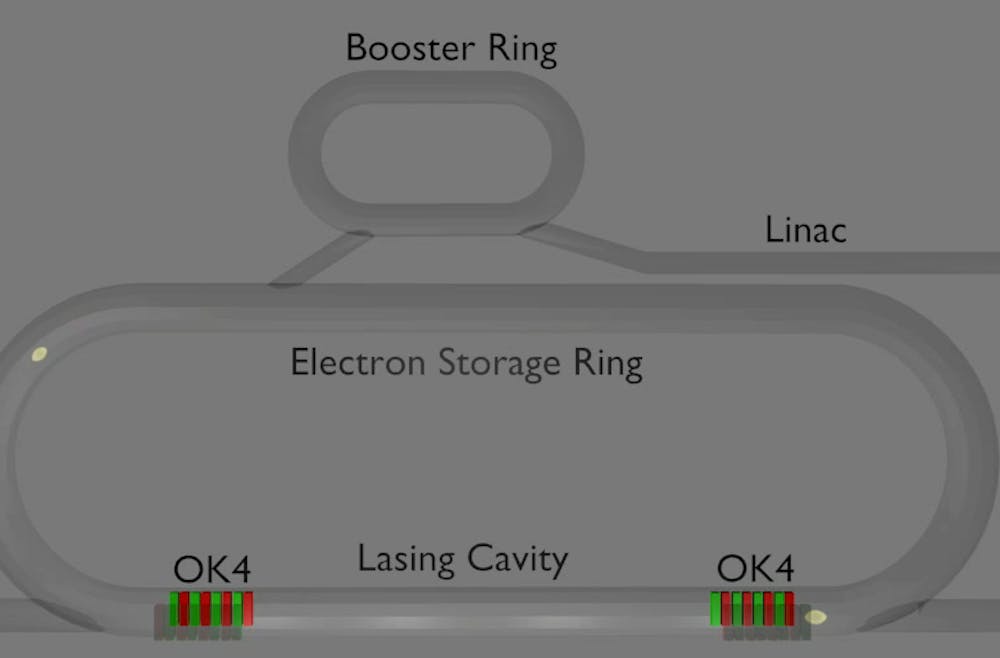State officials have strongly criticized the University’s safety procedures after what they deem the mishandling of uranium in Duke’s Free Electron Laser Laboratory.
According to a final incident report from March 3, a Uranium-235 source was compromised Feb. 11 after a researcher bent “the corners of the source to fit in a target holder.” Jim Jones from the Office of Communications for N.C. Department of Health and Human Services wrote to The Chronicle that the capsule was a postage stamp-sized wafer containing 1.5 grams of Uranium 235.
The report goes on to say that potential contamination was discussed between researchers, but that the concern was dismissed and University reporting procedures were not followed. It continues by stating that no contamination surveys occurred at the source of the incident—which took place in the Upstream Target Room at the High Intensity Gamma Source located in FELL.
The Radiation Protection Section was only called Feb. 15—four days later—after another researcher reached out, the report said. Later that week, RPS was notified there had been contamination outside of the HIGS area and that other parts of FELL had been contaminated.
Eventually, RPS requested a contamination survey that even encompassed the researchers’ residences or hotel rooms. A toilet seat in one researcher’s residence was found to have contamination, and the surface was then decontaminated.
The incident report states several safety procedures were not followed. For example, RPS discovered that researchers consumed beverages in a radiation use area, and that proper protective gear was not used in addition to the lack of prompt reporting.
As a result of the incident, the report states that Duke’s High Intensity Gamma Source operations would be shut down until March 27 while corrective actions are implemented. The lab manager was demoted and replaced by a Duke Radiation Safety Program Health Physicist. Administrators have committed to funding the DRSP and changing its training protocols, the report notes. All new researchers will have to undergo face-to-face safety and procedural training instead of the online trainings previously required.
The results of additional medical tests on potentially affected personnel are still pending, the March 3 report notes.
A letter from Travis Cartoksi, a health physicist in the Radioactive Materials Branch of the North Carolina Department of Health and Human Services, condemned the University’s “negative safety culture.” The letter was sent to Terry Yoshizumi, the University’s radiation safety officer, based on a site visit and interviews conducted Feb. 15 through 17.
“In addition to the findings of noncompliance during this inspection, the [Radiation Protection Section] finds it necessary to impress upon Duke University a concern for the observed negative safety culture,” Cartoksi wrote. “This is evidenced by employees’ disregard for raised safety concerns from researchers, improper reporting to radiation safety and failure to conduct immediate leak tests and contamination surveys which might have stopped the spreading of U-235 contamination into uncontrolled areas.”
Cartoksi added that Yoshizumi will be notified if Duke will face “escalated enforcement.” His letter notes that possible outcomes of an “escalated enforcement” action include increased inspection frequency and potential civil penalties.
Michael Schoenfeld, vice president for public affairs and government relations, noted in a statement that the University takes seriously its responsibility to safely handle radioactive material.
"This is reflected in the University’s excellent safety record and well-established policies and procedures that are promoted throughout the institution," he wrote. "Unfortunately, those established policies and procedures were not followed in this case, and the University has taken immediate action to investigate this failure and put in place corrective measures."
Duke has until March 31 to notify North Carolina of corrective actions.
Editor's note: This article was updated Wednesday at 4:30 p.m. to include Schoenfeld's statement.
Get The Chronicle straight to your inbox
Signup for our weekly newsletter. Cancel at any time.

